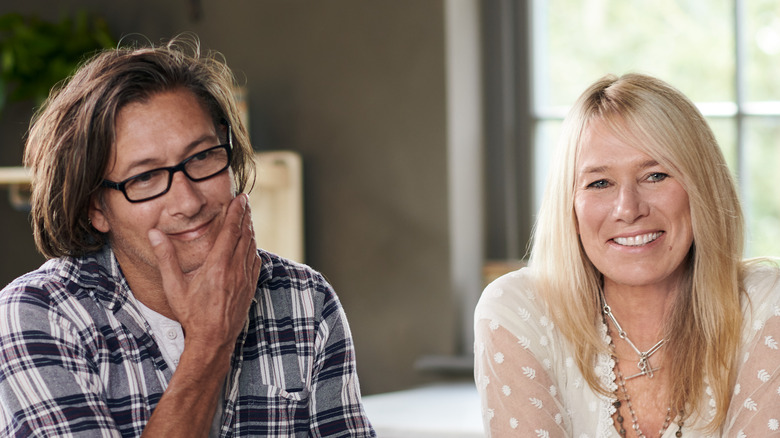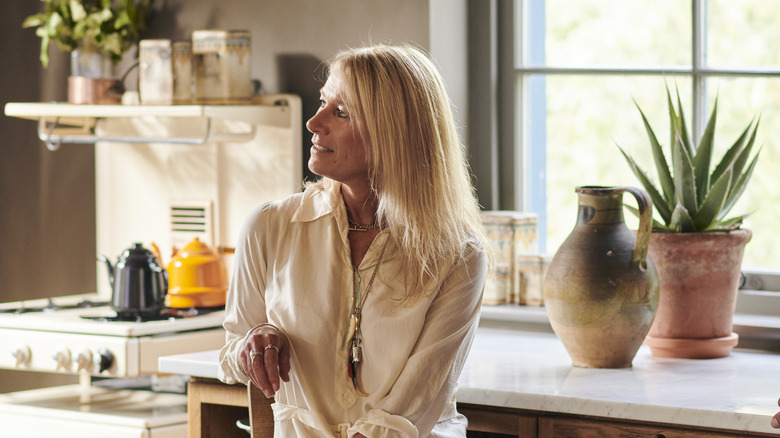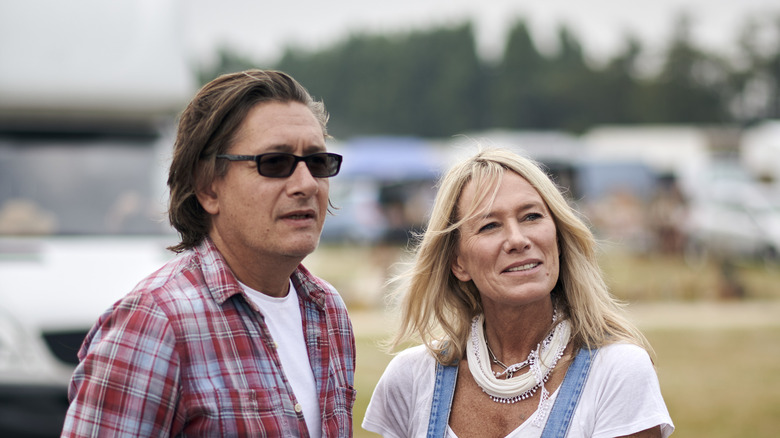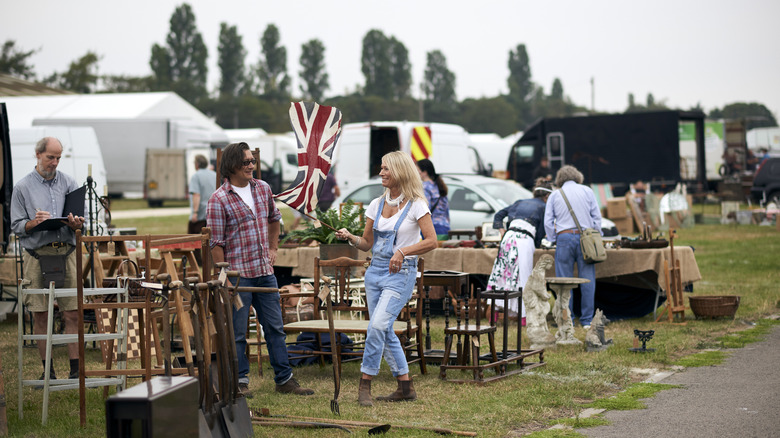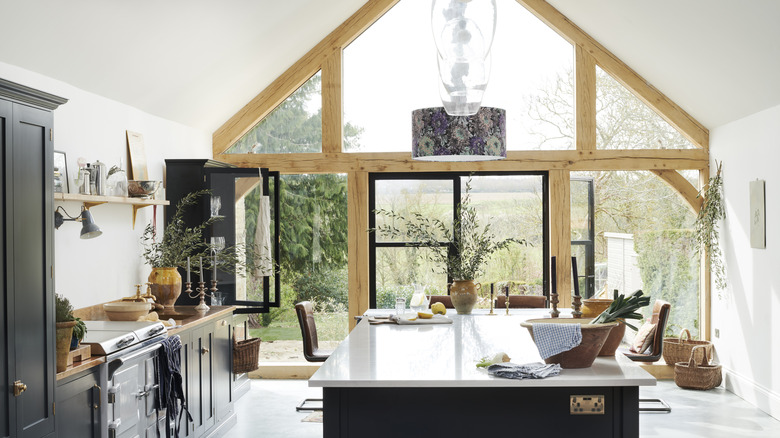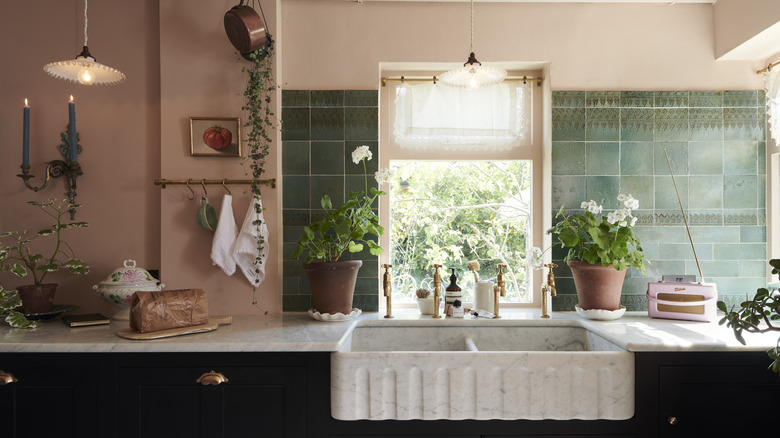Paul O'Leary And Helen Parker Talk For The Love Of Kitchens - Exclusive Interview
Magnolia Network stars Paul O'Leary and Helen Parker prefer to skip design gimmicks and trends and instead let their quality of work and craftsmanship set them apart.
As director and creative director, respectively, of Britain's hugely popular deVOL Kitchens, Paul and Helen channel their keen sense of style and timeless design aesthetic to create beautiful, one-of-a-kind kitchens for clients. Working from their 16th-century mill in the heart of the English countryside, which has since been transformed into a stunning, spacious, globally-renowned studio, the designing duo and real-life partners collaborate with their team to expertly transform ordinary kitchens into works of art.
Photos of their stunning kitchen designs have gained popularity around the world, and the pair have also managed to garner a reality television following with the success of their Magnolia Network series, "For the Love of Kitchens," which highlights the captivating work that deVOL Kitchens does for clients — all with varying preferences, design styles, and expectations.
In an exclusive interview with House Digest, Paul O'Leary and Helen Parker discussed Season 2 of their show, shared their secrets for success, and offered advice for those looking to transform their own kitchens.
Paul and Helen love to spot the differences between American and English clients
Congratulations on Season 2 of the show. Do you have any moments in particular that you're excited for fans to see or any favorite moments from filming this season?
Helen Parker: My favorite bits were when we went to New York to actually meet our American customers — that was at the very end. It was the last two episodes they asked us to [do] if we do two additional episodes in America. We're excited to see how people think they differ from the English ones.
Paul O'Leary: We do quite a lot of kitchens in America. We did even before we had the TV program because we've got a shop in New York, and there are very noticeable differences between English and American customers. American customers are always nice and friendly and trusting and patient. But they also want to try lots of different things.
Parker: They take a little bit longer to settle on a design, but when we met them, they were much less reserved in their enthusiasm for being on the show, which was lovely. English people are a little bit more ... They don't want to appear to be too excited or make too much effort. It's a bit more of a standoffish way. It was lovely because the four couples that we met in America made such an effort, and they were so excited. It was quite different.
O'Leary: It was very different, and it was very weird, because for the first time, we were recognized in the street. If we were out in a bar, people would come up and talk to us, and that's never happened to us before.
Parker: That was actually a bit crazy. Even when we were walking down the street, people came up to us. It was quite surreal. The odd person will recognize us if they come into one of our showrooms, but not walking down the street or in a hotel. We stayed in a hotel near our showroom, and literally maybe three or four times a day, somebody would come up to us and ask if they could have a selfie with us or say that they were excited. We had our five minutes of fame.
The early years
How did you both get started with interior design?
O'Leary: I remember my mom saying to me when I was a kid, "You are going to be really creative and artistic, because you are not like my other children." She said, "Nobody else can see a dragon in that curtain, but you can see a dragon in that curtain." I decided to go and study product design, which is mostly furniture design, but you also work with other materials, metal and plastics and stuff. It's not an interior design course; it's a product design course. You half-engineer, half-design, to learn how to make stuff. Ever since I was 20 years old, I studied design and set up a design consultancy before I even graduated.
We decided we'd concentrate on furniture, and we spent most of our time restoring antique furniture, which is where our style comes from, because we fell in love with all the old furniture that we restored. As we started restoring furniture, people would ask us to make things for kitchens or find them an old cupboard that would go in their kitchen. This was the '80s, so there were a lot of people wanting farmhouse-style kitchens in stripped pine. That was the fashion at the time. Business and where customers came from directed me into kitchens. I could have gone in any direction.
Parker: I don't have quite such an educated past as Paul, because I was always interested in — I don't think I thought it was interior design at the time — but I was creative. I would make clothes and jewelry, but only in my spare time. I never considered doing it as a career or going to university, which was so crazy when I look back on it now, because it was all I did — be creative. I did random jobs, left school when I was 16, didn't get any qualifications, and ended up getting married and having children and still never having a career that I enjoyed.
I got a job in this deli, and Paul's shop was a few yards away, and he would come in for lunch. I saw him in passing, and I knew him because I'd taken furniture to be stripped many years before that. One day when I was leaving, he jumped in the passenger seat of my car and shut the door. He chatted to me about, did I like my job? Did I think I would like to do something different?
I said, "Well, I haven't got any qualifications. I've got kids, I can't use a computer, I think this is a bad idea." But he asked me to draw my kitchen. I can draw and I can write — they're the two things that I can do. He asked me to draw my kitchen and write him a letter and explain how I would like to change my kitchen. I'm sure you can imagine that was quite a project for me. My head was in a bit of a spin, but after a couple of days, I perfected it. Paul taught me how to draw kitchens by hand.
Why the deVOL aesthetic works so well
What is it about your design work and your design aesthetic that you think sets you apart from other designers?
O'Leary: We are traditional, and that time that I spent restoring antique furniture gave me an appreciation of the proportions and the way things used to be made. Now, I'm such a stickler that our furniture has to get all those things.
Most designers always try to do something new and different. With classic-styled furniture ... Let's face it; we all live in — well, certainly in this country — the average age of the house in this country is a hundred years old, and there are many houses that are several hundred years old. Classic-style furniture is always going to look right in them. Yet lots of people are making furniture that, in my opinion, looks out of place in that style of house. But that's because designers are always trying to do something different.
I wasn't driven by that because I'd been working for quite a few years, and I'd fallen in love with Georgian and Victorian furniture. All of our furniture is classic, and that's why it's popular. We haven't tried to do anything brand new. Even our new ranges like the Haberdasher's range, they're still nostalgic — they're styled around old haberdashery shops, gentlemen's outfitters, where it's all oak and glass, and it's a traditional shop with a bell on the door and it smells a certain way and you get nice service. It's calm, and it's quiet. People find that nostalgic.
It's the photographs, which are all important. They're emotive and conjure up a feeling of home, and that's all Helen. That didn't happen before, because I've displayed the furniture in an obvious way. I tried to sell a few things alongside our furniture, like pottery, to make it look a little bit more interesting [and] get people coming into the shop more often. She started bringing all these things that made it feel like a home into our kitchen displays, and our photos went up a level. Our website went up a level; our social media went up a level; our followers went up.
If you walk into most kitchen showrooms, it baffles me that they've literally gone down to the local department store and bought some candles and some vases and some white crockery and put the odd bit in a few cupboards and go, "There you go. Styled." Helen is the absolute opposite of that. She has a million ideas, and she worries about it and thinks about it for weeks, and buys things from special places that nobody else knows about, and goes to a place that she's styling with armfuls and baskets full of props. Not a single one of them would you know where to buy it, because it would be a unique object that she'd found — maybe one of her own things, maybe something from a local grocery store, like a farm shop, all unique things. It's important for interior designers to make sure that they never do anything ordinary.
Parker: We both had our points of view. Paul's was the furniture; mine was the styling. Together, that's what makes deVOL.
The importance of kitchen design
Why do you think the kitchen is such an important part of the house?
Parker: The kitchen is the place that I always end up being, as I always have done literally ever since I was a small child. We didn't watch television — I didn't have a television. We always sat around the kitchen table. It was a big old house. When I got married and had children, I was really into cooking, so I loved having the kids in the kitchen helping me or eating or doing their homework because everybody felt like they were together in the kitchen.
If you've got a nice big kitchen with a table, you get home from work, you have a cup of tea, you put dinner on, the kids do their homework, you chat around the table ... If you have friends, you end up sitting around the table with a bottle of wine until you go to bed. It's the room that has to perform lots of different tasks, and it's the place where it's the most sociable, comfortable place when you bring someone into your house. You perhaps sit in your drawing room or your lounge — then, maybe it feels a bit more formal, whereas if you're in the kitchen, you just hang out there.
What advice would you give to somebody who is looking to make design changes in their kitchen but isn't sure where to start?
O'Leary: It comes down to budget. It seems like a lot of people these days get an interior designer involved. I don't understand that, because if you wanted to buy a car, would you go to a car salesman and say, "What car should I have?" You know you wouldn't. You'd choose. You'd have your own ideas, or someone [would say], "I want a spacious car with plenty of room in the back for a long weekend, camping trips." You make your own choices. But with interior design, people seem to defer the choices to somebody else. I don't think you should do that.
You should think about, "How do we want to live as a family, what's important to us?" The first thing I'd always say is to decide what room in the house it should be. Don't think, "It has to be this room because that's where the kitchen is. The sink has to be there because that's where the plumbing is." If you want to make a difference to the way you live, and you want it to improve your lifestyle and make you happier as a family, then think about what you want from a kitchen.
There are lots of ways that kitchens can improve your life: having that inside-outside connection, so doors out onto the garden; having a comfortable sofa; having some dining space, even if it's just a breakfast bar so that people can hang out with you. These are all the first things that you try and get. My advice would be to think for yourself. Allow yourself to be creative; don't ask somebody else. It's all blooming common sense. You don't need a rule book — you just need to think about how you live, how you use a kitchen, and what you want to get out of it.
Upcoming projects are in the works
Are you working on any new projects outside the show?
O'Leary: We're doing up an Airstream caravan, the aluminum 1960s Caravan, which I've always loved. We're doing one of those up at the mill at the moment, and we're hoping that we're going to make the interior the nicest Airstream interior you've ever seen. We want to go and do a bit of traveling, and we want to do a bit of filming along the way. The traveling is going to have a purpose — this might be the basis for a TV program, but lots of discussions to have before that might happen. But we're going to do it anyway. Whether it is a TV program or not, we're going to do it.
Parker: We'd like to look around other people's kitchens — not deVOL kitchens — but maybe more European kitchens where people's homes are much more —
O'Leary: Basic.
Parker: They don't change things the way that we do, particularly in the Mediterranean. They have a kitchen that was in the house, and they don't think about changing it because it's a much simpler room, maybe with stone sinks and old cupboards. We like the idea of that and easy access to the outside and maybe cooking outside. We'd like to look at not necessarily fancy kitchens, but traditional home kitchens, whether they're families or an old person, somebody who's into cooking ... maybe in Italy or Spain or Greece.
O'Leary: Everybody loves this idea of Mediterranean life — the idea that the whole family, grandmas, uncles, aunties, cousins, grandkids, are all running around outside until midnight. They're all sitting out in cafes and drinking a bottle of red wine, and there's music playing, and there's local bands playing, and everybody loves that idea. Yet we live this segregated life where we have this completely isolated family unit.
If you want to enjoy life, then making your kitchen as sociable as possible would hopefully ... If you get your kitchen right, then it becomes a space where you feel like you want to invite people around and have long evenings where it's not just, "Cook dinner, eat it, watch television." They wouldn't dream of doing that in the Mediterranean because they're too busy having fun dancing on the tables. We want to experience that and try and bring some of that into our kitchen design.
Stream Season 2 of "For the Love of Kitchens" now on HBO Max, discovery+, and the Magnolia app.
This interview was edited for clarity.
